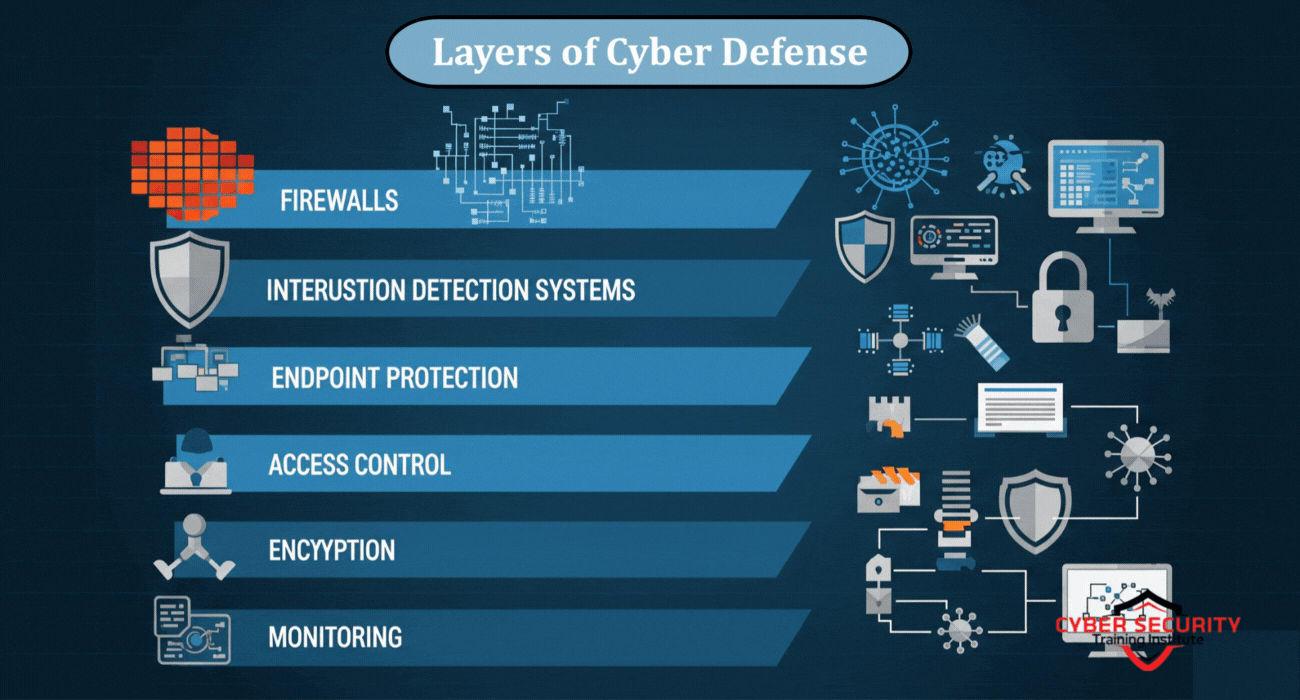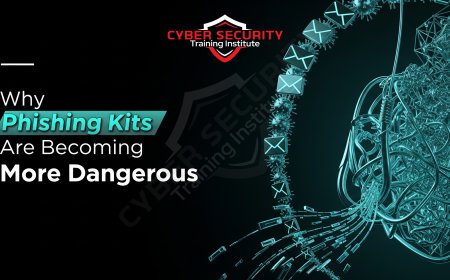Layers of Cyber Defense | Understanding the Defense-in-Depth Strategy
In today’s digital world, cyber threats are everywhere. From phishing emails to sophisticated ransomware attacks, protecting sensitive information has never been more critical. Imagine your organization’s data as a castle: you wouldn’t rely on a single gate to keep intruders out, would you? That’s where the defense-in-depth strategy comes in—a multi-layered approach to cybersecurity that builds multiple barriers to stop attackers in their tracks. In this blog, we’ll break down the defense-in-depth strategy in a way that’s easy to understand, even if you’re new to cybersecurity. Let’s dive into how this layered approach keeps your digital castle safe.

Table of Contents
- What is Defense-in-Depth?
- Why Defense-in-Depth Matters
- Key Layers of Defense-in-Depth
- Implementing a Defense-in-Depth Strategy
- Challenges of Defense-in-Depth
- Conclusion
- Frequently Asked Questions (FAQs)
What is Defense-in-Depth?
Defense-in-depth is a cybersecurity strategy that uses multiple layers of security controls to protect an organization’s data and systems. Think of it like an onion: each layer provides protection, and even if one layer is breached, others are in place to stop the attack. The goal is to make it as difficult as possible for attackers to succeed by slowing them down, detecting their presence, and limiting the damage they can cause.
This approach originated in military strategy, where castles were designed with multiple defenses—moats, walls, and archers—to protect against invaders. In cybersecurity, the same principle applies: no single security measure is enough. By combining physical, technical, and administrative controls, defense-in-depth creates a robust shield against cyber threats.
Why Defense-in-Depth Matters
Cyberattacks are becoming more sophisticated every day. Hackers don’t just try one method; they probe for weaknesses, exploit human errors, and use advanced tools to bypass defenses. A single firewall or antivirus program isn’t enough to stop them. Defense-in-depth matters because it:
- Reduces the risk of a successful attack by creating multiple barriers.
- Provides redundancy, so if one layer fails, others can still protect the system.
- Helps detect and respond to threats early, minimizing damage.
- Protects against a wide range of threats, from malware to insider attacks.
In short, defense-in-depth ensures that your organization isn’t left vulnerable if one security measure fails. It’s about building a comprehensive system that works together to keep threats at bay.
Key Layers of Defense-in-Depth
The defense-in-depth strategy is built on several layers, each addressing different aspects of cybersecurity. Below, we’ll explore the main layers and how they work together to protect your organization. The table below summarizes these layers and their purposes.
| Layer | Description | Example Tools/Methods |
|---|---|---|
| Physical Security | Protects physical access to devices and infrastructure. | Locks, security cameras, biometric access controls. |
| Network Security | Secures the network from unauthorized access and attacks. | Firewalls, intrusion detection systems, VPNs. |
| Endpoint Security | Protects devices like computers and phones from threats. | Antivirus software, device encryption, patch management. |
| Application Security | Ensures software and apps are free from vulnerabilities. | Secure coding practices, regular updates, web application firewalls. |
| Data Security | Protects sensitive data from unauthorized access or loss. | Encryption, access controls, data backups. |
| User Security | Educates and empowers users to avoid mistakes that lead to breaches. | Training programs, phishing simulations, strong password policies. |
| Administrative Security | Policies and procedures to guide security practices. | Security policies, incident response plans, regular audits. |
Physical Security
Physical security is the first line of defense. If someone can physically access your servers or devices, they can bypass many digital protections. Locks, keycard systems, and security cameras help prevent unauthorized access to data centers or offices. For example, a biometric lock on a server room ensures only authorized personnel can enter.
Network Security
Network security focuses on protecting the pathways that data travels through. Firewalls act like gatekeepers, filtering out malicious traffic. Intrusion detection systems (IDS) monitor for suspicious activity, while virtual private networks (VPNs) encrypt connections to keep data safe when employees work remotely.
Endpoint Security
Endpoints are devices like laptops, smartphones, or tablets that connect to your network. Each one is a potential entry point for attackers. Antivirus software, regular software updates, and device encryption help protect these devices from malware or theft.
Application Security
Software vulnerabilities are a common target for hackers. Application security involves writing secure code, testing for weaknesses, and using tools like web application firewalls to block attacks on apps. Keeping software updated is critical to fixing known vulnerabilities.
Data Security
Data is often the ultimate target of cyberattacks. Encryption scrambles data so only authorized users can read it. Access controls ensure only the right people can view or edit sensitive information, and regular backups protect against data loss from ransomware or hardware failures.
User Security
Humans are often the weakest link in cybersecurity. Phishing emails, weak passwords, or clicking suspicious links can open the door to attackers. Regular training teaches employees how to spot threats, while strong password policies and multi-factor authentication (MFA) add extra protection.
Administrative Security
Policies and procedures tie everything together. A clear security policy outlines rules for employees, like how to handle sensitive data. An incident response plan ensures your team knows what to do during a breach, and regular audits help identify weaknesses before attackers do.
Implementing a Defense-in-Depth Strategy
Building a defense-in-depth strategy requires careful planning. Here’s how organizations can put it into practice:
- Assess Risks: Identify your organization’s most valuable assets (like customer data) and the threats they face.
- Layer Defenses: Implement controls at each layer, from physical security to user training.
- Test Regularly: Conduct penetration testing and vulnerability scans to find weak spots.
- Monitor Continuously: Use tools like security information and event management (SIEM) systems to watch for suspicious activity.
- Update and Adapt: Cyber threats evolve, so your defenses must too. Keep software updated and revise policies as needed.
Small businesses can start with basic measures like strong passwords and antivirus software, while larger organizations may invest in advanced tools like SIEM systems or dedicated security teams.
Challenges of Defense-in-Depth
While defense-in-depth is effective, it’s not without challenges:
- Cost: Implementing multiple layers can be expensive, especially for small organizations.
- Complexity: Managing multiple systems requires expertise and coordination.
- User Resistance: Employees may find security measures like MFA inconvenient, leading to pushback.
- Evolving Threats: Hackers constantly develop new techniques, requiring ongoing updates to defenses.
Despite these challenges, the benefits of a layered approach far outweigh the difficulties. With careful planning, organizations can balance cost, complexity, and security.
Conclusion
Defense-in-depth is like building a fortress for your organization’s data. By combining physical, technical, and administrative controls, this strategy creates multiple barriers to stop cyber attackers. From firewalls and encryption to employee training and security policies, each layer plays a vital role in keeping threats at bay. While implementing defense-in-depth can be challenging, the protection it offers is worth the effort. In a world where cyber threats are constantly evolving, a multi-layered approach ensures your organization stays one step ahead. Start small, assess your risks, and build your defenses layer by layer—your digital castle will thank you.
Frequently Asked Questions (FAQs)
What is defense-in-depth?
Defense-in-depth is a cybersecurity strategy that uses multiple layers of security controls to protect data and systems from attacks.
Why is a single security measure not enough?
No single measure can stop all threats. Multiple layers provide redundancy and increase the chances of stopping an attack.
What are the main layers of defense-in-depth?
The main layers are physical, network, endpoint, application, data, user, and administrative security.
How does physical security fit into cybersecurity?
Physical security prevents unauthorized access to devices and infrastructure, like locking server rooms or using biometric controls.
What is network security?
Network security protects the pathways data travels through, using tools like firewalls and intrusion detection systems.
Why is endpoint security important?
Endpoints like laptops and phones are common entry points for attackers, so protecting them with antivirus and encryption is critical.
How can I secure my applications?
Use secure coding practices, keep software updated, and deploy web application firewalls to protect apps from attacks.
What is data security?
Data security protects sensitive information with encryption, access controls, and backups to prevent unauthorized access or loss.
How do users impact cybersecurity?
Users can accidentally cause breaches through phishing or weak passwords, so training and strong policies are essential.
What is administrative security?
Administrative security involves policies, procedures, and audits to guide and maintain cybersecurity practices.
Can small businesses use defense-in-depth?
Yes, small businesses can start with basic measures like antivirus, strong passwords, and employee training.
How do I start implementing defense-in-depth?
Assess your risks, identify key assets, and implement controls at each layer, starting with the most critical areas.
What is a firewall?
A firewall is a network security tool that filters incoming and outgoing traffic to block malicious activity.
What is multi-factor authentication (MFA)?
MFA requires multiple forms of verification, like a password and a code sent to your phone, to access an account.
Why is employee training important?
Training helps employees recognize threats like phishing emails, reducing the risk of human error.
What is an incident response plan?
An incident response plan outlines steps to take during a cyberattack, like isolating systems and notifying stakeholders.
How often should I update my defenses?
Regularly update software, policies, and training to keep up with evolving cyber threats.
What is penetration testing?
Penetration testing simulates cyberattacks to identify vulnerabilities in your systems before hackers exploit them.
Is defense-in-depth expensive?
It can be costly, but starting with affordable measures like free antivirus or basic training can make it manageable.
Can defense-in-depth stop all attacks?
No strategy is foolproof, but defense-in-depth significantly reduces the risk and impact of attacks.
What's Your Reaction?
 Like
0
Like
0
 Dislike
0
Dislike
0
 Love
0
Love
0
 Funny
0
Funny
0
 Angry
0
Angry
0
 Sad
0
Sad
0
 Wow
0
Wow
0














